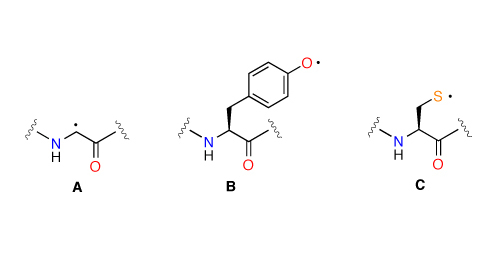Research Area C
Publications 2011
16-Oct-2013
The knowledge of the intersection space topography of electronic states is essential for deciphering and predicting photoinduced reactions. Michl and Bonac̆ić-Koutecký developed a two-electron two-orbital model that allowed first systematic studies of the chemical origin of conical intersections in strongly polar systems. We generalize this approach to arbitrary ... READ MORE
02-Sep-2011
A class of photoreceptors occurring in various organisms consists of domains that are blue light sensing using flavin (BLUF). The vibrational spectra of the flavin chromophore are spectroscopically well characterized for the darkadapted resting states and for the light-adapted signaling states of BLUF domains in solution. Here we present a theoretical analysis of ... READ MORE
The First Picoseconds in the Life of Benzhydryl Cations: Ultrafast Generation and Chemical Reactions
18-Feb-2011
For benzhydryl chloride compounds we observe that photodissociation only leads to radical pairs. The typically observed cations are formed by subsequent electron transfer. Reactions of cations in neat alcohols can then occur within 2.6 ps. ... READ MORE
10-Feb-2011
The functional reactions in blue light photoreceptors generally involve transiently reduced flavins exhibiting characteristic infrared (IR) spectra. To approach a theoretical understanding, here we apply density functional theory (DFT) to flavin radicals embedded in a molecular mechanics (MM) model of an aqueous solution. Combining a DFT/MM approach with ... READ MORE
21-Jan-2011

The conformational space of dipeptide models derived from glycine, alanine, phenylalanine, proline, tyrosine, and cysteine has been searched extensively and compared with the corresponding Cα dipeptide radicals at the G3(MP2)-RAD level of theory. The results indicate that the (least-substituted) glycine dipeptide radical is the thermochemically most stable of ... READ MORE

Electrons and their dynamics are involved in bond breaking and formation, thus the idea to steer chemical reac- tions by localization of electronic wavepackets seems natural. The formation of a localized electronic wavepacket requires the superposition of two or more appropriate electronic states through e.g. an external electric field. The guiding of such a ... READ MORE
The mechanism of formation of Dewar lesions (see scheme) has been investigated by using femtosecond IR spectroscopy and ab initio calculations of the exited state. The 4π electrocyclization is rather slow, occurs with an unusual high quantum yield, and—surprisingly—is controlled by the phosphate backbone. ... READ MORE

The photophysics of indigo as well as of bispyrroleindigo, the basic chromophore of indigo, has been investigated with ab initio electronic-structure calculations. Vertical electronic excitation energies and excited-state potential-energy profiles have been calculated with the CASSCF, CASPT2 and CC2 methods. The calculations reveal that indigo and bispyrroleindigo ... READ MORE


